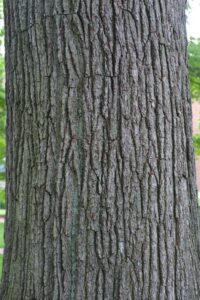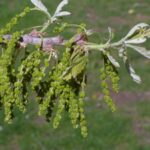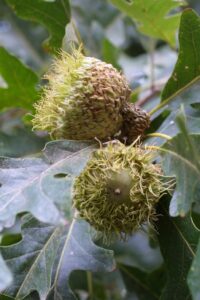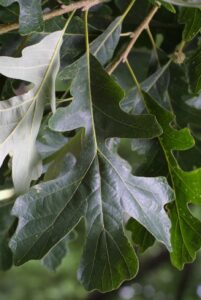Botanical Name:
Quercus macrocarpa
Family Name:
Fagaceae
Description:
Bur oak is a large deciduous tree with a massive trunk and broad, rounded crown. It is an excellent shade tree but requires a large lawn or a park to allow it to grow to full size and shape. It can be distinguished from the closely related white oak by its corky, deeply furrowed bark, its glossy green, deeply lobed leaves, and the acorn cups that enclose at least half of the acorn and have a distinctive fringe of bracts around the margin.
Size:
60-100’ tall; 60-80’ spread
Habitat and Range:
Bur oak has a large range that includes essentially all of the midwestern U.S. and adjacent Canada and that stretches north into southern Manitoba, west to the Black Hills of South Dakota and south through eastern Texas to the Gulf Coast. It can be found in several habitats, from bottomland to upland woodlands and also in prairie savannas, where its thick bark gives it protection from fires.
Attributes:
Leaves of bur oak are dark, glossy green on the upper surface, but paler green on the lower surface. They are generally wider at the tip than at the base and have deeper lobes than other members of the white oak group in our area. The deepest lobes are typically in the lower half of the leaf. Autumn color is a yellow-brown. Its twigs often have corky ridges.
Wildlife Value:
Like many of our oaks, bur oak is an important source of food and shelter for a wide variety of insects – butterfly and moth caterpillars, long-horned and related beetles, treehoppers, various bugs, and many more. Many of our insectivorous songbirds eat these insects. Many species of birds and mammals eat the acorns.
Did you know?
• Bur oaks can live for several hundred years.
• They are well adapted to survival in the prairies of the Great Plains and can be found along riverways all the way to eastern Wyoming.
• The largest bur oak in Indiana is in Posey County and has a trunk diameter of 4 feet, a height of 111 feet and a crown diameter of 104 feet.
Benefits to Our Community (based on carbon dioxide sequestered, storm water runoff avoided, and air pollution removed each year):
Over the next 15 years, this tree will give back $5,055 worth of benefits to our community.




